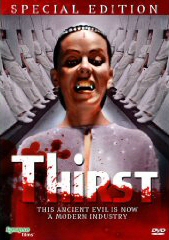
Perhaps no other archetype of supernatural horror has been engrained in the human consciousness so forcefully than that of the vampire. The undead, Nosferatu, Strygia: no matter the name, this creature of the night, be it shambling corpse (as it was traditionally depicted in folklore) or suave and sexy impostor duded out in an evening suit, has graced more horror fiction, stage plays, and films than any other symbol than the ghost. Unfortunately, no other monster has also been drained of as much of its originality. What began centuries ago as a vibrant manifestation of human fear and fascination with death, the unknown, and later sexuality, the vampire has been trotted out in so many re-hashes of stereotypes and clichés that it is increasingly difficult for artists to inject the hoary figure with new blood. Perhaps this is due to lazy storytellers recycling past elements or simply falling in step beside the newest image of the vampire as a metro-sexual pretty boy filled with teenaged angst and about as scary as a repeat of Family Ties. Thirst, a little known and bold revision of the vampire myth from Australia, re-imagines the legend of these blood drinkers and injects a fresh concept with thematic vitality.
Thirst is intriguing as a story, surpassing the usual supernatural/sexual motifs (though not altogether ignoring them) to focus on the primal corruptive struggle for power inherent in the mythos. Kate Davis is an enticing businesswoman who has 'got it together' before she is abducted by a technological and culturally sophisticated group of modern vampires who have turned the traditional craft of bloodsucking into a systemized business process. Kate is a desirable target to these GQ Nosferatu because she is a descendent of Countess Elizabeth Bathory. Ms. Cameron heads the cult, along with such unusual suspects as Mr. Hodge, Dr. Gauss, and Dr. Fraser, who is the most sympathetic of the group. Kate is ushered to the 'blood' farm where these delightful creatures drain humans for bottled blood. The cult intends to groom Kate to enjoy drinking blood, employing such devices as chemicals and technology (and not a little arm twisting) with the script's chief dynamic residing in Kate's emotional struggle and independence.
Filmed in 1979, Thirst came at the middle of a vampire fever. King had written Salem's Lot which was evocatively filmed for television by Tobe Hooper and Werner Herzog's Nosferatu competed with another remake of Dracula. Small wonder that a low budget take on the same subject was ignored. A shame, considering the unique political subtext and the filmmaker's attention to atmosphere. Linking the biological and supernatural elements of the vampire with big business and politics -- two leeches if ever there were -- director Rod Hardy and writer John Pinkney explore the truly vampiric relationship between victim and victimizer, mirroring the traditional bloodsucker with corporate strategy. While the plot isn't particularly convincing, and the dialogue is overly vague, the theme injects vitality into an old trope. More importantly is the satisfying manner in which the story draws such powerful parallelisms between traditional bloodsucking and the predatory war between the classes, which is emphasized by the aristocratic nature of the corporate vampire clan. This disturbing and highly polished affair also points a scathing finger at consumerism, supporting the central conflict between Kate and the clan without preaching. Perhaps the most commendable accomplishment here is the doubtful nature of reality, reflected in both the fragmentary non-linear structure and the theme of mistrusted perception. This later element is emphasized by the devious manner in which Kate is forced to eat blood, which include such surreal moments as blood through the shower and squirting from a chicken.
Synapse films carries over the transfer and extras from the original 2003 Elite disc. The film is presented in anamorphic 2.35:1 widescreen, sporting sharp picture detail and bold color schemes. Dolby Digital Mono (English) nicely balances the effects and dialogue. Extras include the Brian May score, a Theatrical Trailer, Three TV Spots, Filmographies, and most significantly, an Audio Commentary with director Rod Hardy and producer Antony Ginnane. This discussion creates a sense of cultural and aesthetic context. These two gentlemen discuss a variety of issues, including its limited budget, location shoots, the cast and crew, and the state of filmmaking in Australia at that time.
Review by William Simmons
| Released by Synapse Films |
| Region 1 - NTSC |
| Not Rated |
| Extras : |
| see main review |